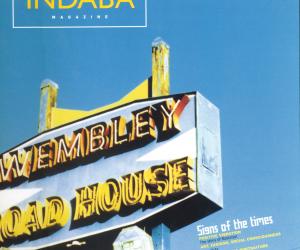First Published in

I have to be happy right now. Last week I 'sold' a global ad campaign to a client, the creative work having an idea that was original and big, executed with purity and simplicity and great graphic punch. The campaign was completely bought, with the client only removing that which had been introduced as a softening 'compromise' element in case the hardline was not bought.
So rare is this kind of success, I know I have to treasure it. Right now, despite a range of aggravations that attempt to preoccupy my mind, I have to keep pulling last Thursday's success out of my mental locker, looking at it and feeling good. I know this sounds a little childish, indulgent, way too egotistical to interest you really (you would need it to be your success to get any of the pleasure!), but there is a useful general lesson for us to learn in my behaviour.
That lesson is to see the glass as 'half-full' rather than 'half-empty'. Not only is this a useful rule in life, (if you don't want to be eternally miserable), but it is particularly helpful in being able to push forward with creative work. So often the creative - whether art director, designer, photographer, film-maker, whatever - is inclined to get rather depressed over the many restrictions that beset getting good work done. I've seen it happen with the designers and art directors in my team. Just because their ideas get chipped away and compromised by a shifting brief and a diminishing budget, they are inclined to sulk. They take it personally, when it is just business trying to happen in its own painful and messy way.
Now of course, taking it personally is inevitable when somebody has just dumped their thoughts and problems all over your great creative idea and asked you to clean it up. You know what you want to do to them, but it won't help the bottom line of your, or your client's, business. In fact, the childish reaction that you naturally feel is likely to only make matters much worse.
By ignoring your bruised creative ego, picking up the cherished remains of your work, and then looking for what to keep, what to learn and what to embrace as the revised brief, you are more likely to find that life moves forward with some purpose. Not easily done, but there is never much alternative to this than retirement from the fray - the behaviour of the injured or defeated.
Hence the case for taking a deep breath and always looking for the glass to be half-full. Or even a quarter. Or even have a drip of the original nectar remaining. There is nothing to be had from fixating on the negatives.
So now I have, rather long-windedly, shared the moral of my current slightly smug state (a condition which may be destroyed within days, if not hours), I can move on to a creative association I made from the above condition.
That is, I was once again - for about the 135th time in my life - stunned by the power of the crop in creative work. 'The crop', that magic of moving in on a key element in a picture so as to channel or change the meaning and increase the graphic impact - is truly a piece of magic. Now it happens that we use crops as an element within the tactical rollout of the above-mentioned campaign, but the point of mentioning it is that there seems to be a greater 'creative philosophy' quality to the crop, above and beyond it sorting out a particular picture need. The crop is no less than a visualisation of a key part of the process in thinking through any problem. We move around the problem, come in on the core issue, and then remove all the extraneous matters so as to see fully and solely the challenge. We crop out the confusion and make simple and powerful the issue we want to deal with. The new meaning of a cropped image can equate to the solution that emerges when you have stripped away all argument and arrived at the core problem. A problem seen as clearly as possible is only one step from its answer.
By way of illustration, I have provided the Indaba editors with some good images to crop the hell out of. They can show you the before and after, the shift of meaning, the power of the crop to pull out a way of seeing that enlightens.
The secret of the crop is to seek the pure point in the image - the reduction that finally encapsulates the message you want from the image, and deletes all the other stuff. Crop until it hurts, and then try to do a little more. Then print it large. And if you are putting copy with the image, crop / edit the copy with the same severe surgical principles. Complication and clutter is easy; purity and simplicity is hard. That's why I am still celebrating last week's win.
By the way, if I was to apply fully the thought above to this article, I would cut it to just one sentence from a paragraph just a short way back: 'a problem seen as clearly as possible is only one step from its answer'. Of course, a tight crop would look great, but be just a little cryptic. And way too short to fill the allotted space. Damn, there's the real world compromising creativity again.









